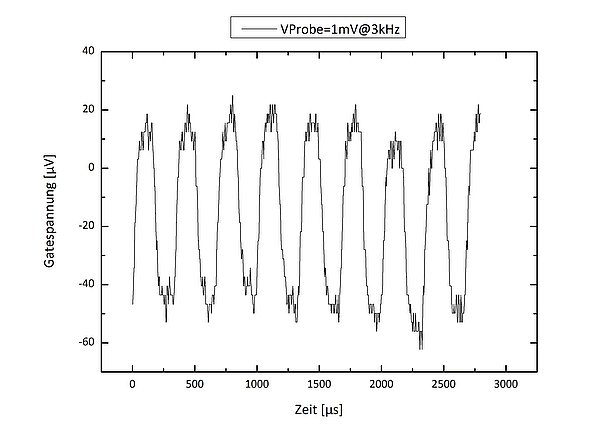Open FET Sensor - Extremely low leakage current Open-Gate Junction FET Electrometer
Ref.-No. 4817
Keywords: Field effect transistor, JFET, sensor, electrometer, AFM, voltage measurement, measurement Technology
The Open FET sensor is a field-effect-based sensor in which the gate electrode is connected only to the signal to be measured and not as usual to other electronic components. By cooling the n-junction FET the leakage current can be reduced to 10-20 A. This means that the Open FET sensor comes very close to an ideal voltage meter. The input capacitance amounts to approx. 5 pF; the full bandwidth is 10 kHz. The input noise is less than 1 µV/√Hz. The left-hand diagram shows the output signal for a square wave signal of 60 μVpp at 3 kHz. Using an integrating mode currents of 10-18 A can be measured, if the bandwidth is reduced. The figure to the right displays the signal at an input current of +/- 1×〖10〗^(-18) A. Despite the extreme sensitivity, the Open FET sensor is relatively robust. Outside of the operating regime it tolerates input currents of a few 10 μA hence protecting itself against electrostatic charging. This means that, in practice, no special precautions have to be taken, as would be required, for example, in the case of a MOS field effect transistor. The Open FET sensor is especially well suited for scanning-force and scanning-tunneling microscopy at low temperatures. The measuring lines can be kept short and an impedance conversion over 12 magnitudes is obtained. The input current outside of the operating regime enables the preparation of the sensor tip at high voltages, e.g. by field emission.
Commercial Opportunities
The Open FET sensor offers the possibility to measure small voltages at extremely high impedance. It is robust and versatile. For example, it can be used in scanning force and scanning tunneling microscopy or as an electrometer. Due to the simple construction, which does not require any further electronic circuitry, it is inexpensive and simple to manufacture.
Current Status
A German patent application was filed, international applications are still possible. On behalf of the University of Duisburg-Essen, we offer interested companies the opportunity to license and further develop the technology.
—
An invention of Uni Duisburg-Essen.




